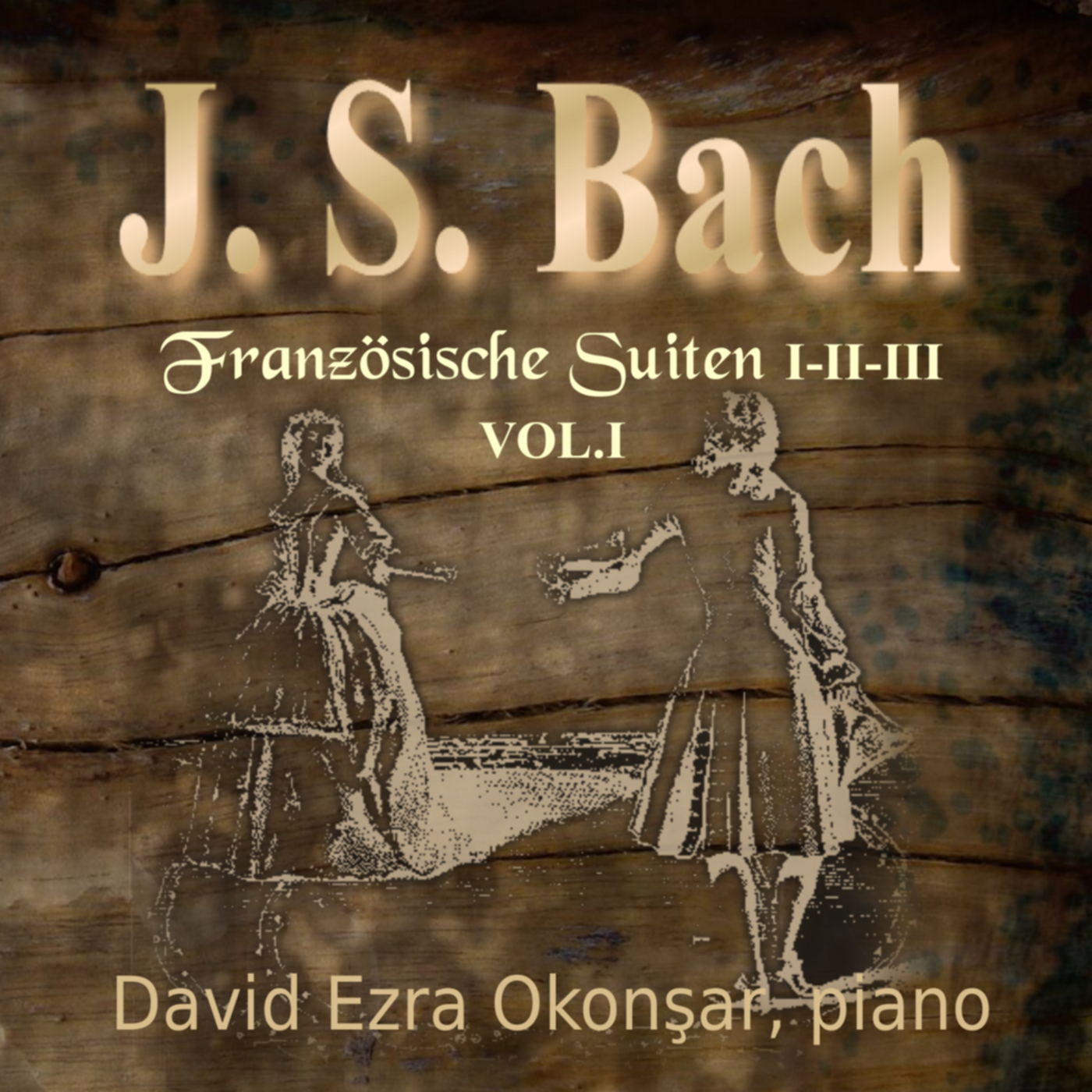

|
The French Suites By J. S. Bach BWV 812 - 817 The French Suites were probably composed at the end of the composer's stay in Cöthen, 1717 - 1723. The first five were cloned in the Clavierbüchlein composed for Anna Magdalena in 1722. In Cöthen, Bach mainly composed non-religious works and he was at the apex of his instrumental style. Different views exist on why these Suites are called "French". Most probably, it is due to the insertion of highly popular French dances in Versailles as: Menuets, Gavottes, Bourrées and Lourées between the usual line of dances: Allemande - Courante - Sarabande - Gigue. Also, we know how great was the impact of the French composers Bach studied the works when he was at Lünebourg and Celle. He has been certainly greatly influenced by the French harpsichord players he openly admired. French Suites have between six and eight movements. They all have repeats in each section and the first three ones, in minor keys, are in a grave mood while the latter three, in major modes, are "lighter". French Suite N.1 in D Minor BWV 812 Allemande
Courante Sarabande Menuet I and II Gigue The Allemande which opens the first French Suite BWV 812 is an extremely refined and noble piece. It is made of an endless serpentine line moving between hands, where the composer displays the incredible amount of subtle contrapuntal imitation game between voices in the most lyrical way. The Italian type of "Courante" which follows, literally runs from one hand to the other and from top to the bottom of the keyboard range and never loses pace. The beautiful Sarabande is subtle and lyrical, based on a motive appearing alternatively at the top and the low voices. A calm and serene four-voice Sarabande which develops in a seemingly naive atmosphere made with an amazing composing mastery. The two charming Menuets follow that almost religious Sarabande. The theme of the first Menuet re-appears inverted in the relative major key (F Major) in the second part of it. The second one, more souple is based on a theme which appears endlessly every four bars at the two top voices. As usual a grave and noble Gigue, highly characterized by its dotted rhythm ends the Suite. It is not like any final movement of a suite which are usually happy and brilliant. Rather it uses the solemn and majestic rhythms and idioms of a French-type Overture: dotted rhythms and fast runs. All this is built upon a strict fugal organization with four entrances of the theme. The second part still displays the four thematic entrances, but this time inverted. Eventually this type of Gigue can be found on some French lute players compositions. French Suite N.2 in C Minor BWV 813 Allemande
Courante Sarabande Air Menuet I Menuet II Gigue The French Suite N.2 in C Minor BWV 813 starts with a grave and noble Allemande featuring a three part ecriture with an extreme diversity in rhythms and elaborations. Souple and smooth, the next Courante is contrasted with the preceding Allemande. It is an Italian style fast Courante with mainly two voices. Compared to the Sarabande of the previous Suite, this one is richly ornamented and presented as a single melodic line over a two-voice accompaniment. The "Air" which follows is a brilliant and virtuoso duet, still dance-like in its elaboration. A short and very gracious pair of Menuets with extreme simplicity and charm come next after the shining "Air". A real French-style Gigue with its dotted rhythms but composed in three eights is, again, the finale of this Suite. French Suite N.3 in B Minor BWV 814 Allemande
Courante Sarabande Menuet I & II (Repetatur Menuet I) Angloise (Gavotte) Gigue The Allemande French Suite N.3 in B Minor BWV 814 is more of a Prelude and less of a dance. Two voices in imitation run throughout and it is very sober in style. The Courante is in the authentic French style, written in 6/4 time. A rich imitative structure prevails, with motives jumping between voices. The Sarabande appears as a soloist's "Air", more tormented than the preceding one in the second Suite. Melodic elements also travel between voices and ranges. From the following set of Menuets, the first one is a very straightforward but amazingly charming piece with two voices. The second one with three voices is more majestic and expressive. Here appears the first French court dance piece: this "Angloise" also titled "Gavotte" does not appear in older publications. It is actually a two-beat French Gavotte yet with a more meandering melody which may justify its (first) title "Angloise". After a fugue-like Gigue in the Suite N.1 and a French type one in Suite N.2, Bach composes here a real Italian-type Gigue which looks like a Passepied. Controversy still exists about the origins of the dance form Gigue, some argue for English sources, others claim it from Italian or French origins. French Suite N.4 in E-flat Major BWV 815 Allemande
Courante Sarabande Gavotte Air Menuet Gigue The Allemande of this fourth Suite, in E-flat Major BWV 815, is a real Overture or Prelude with three voices. It features an incredibly rich contrapuntal elaboration. This "Prelude/Allemande" beautifully introduces the succession of dance-form pieces to follow. The second piece is as usual a brisk Courante in the Italian manner with two main voices. It displays the typical dotted rhythm value to be interpreted as triplets. A tender and lyrical Sarabande follows, which may be cut into three parts of eight bars each. Each section is based on a short motivic idea which appears alternatively at the top and in the bass voices. Next, the Gavotte which is an old French dance very popular at the court of Versailles. It always starts whit a double upbeat. Again a brilliant, virtuoso piece: "Air", which sometimes appears after the Menuet in some editions. Only 16 bars long, the charming Menuet function as an intermezzo between the Air and the Gigue. The final Gigue displays a fugal writing, including the inversion of the theme at the second section, combined with a virtuoso and brilliant ecriture. French Suite N.5 in G Major BWV 816 Allemande
Courante Sarabande Gavotte Bourrée Louré Gigue Probably the most lyrical Allemande ever composed by Bach is in the French Suite N.5 in G Major BWV 816 . The lyricism here takes over the dance idiom. The left hand, starting as an accompaniment includes extremely subtle contrapuntal elements in a delicate imitative structure. This is, as usual, followed by a Courante which may be called "Air" because of its instrumental and virtuoso texture. Then comes one very elaborate and lengthy Sarabande in the French manner. The left hand features an extremely elaborated ecriture. Again, a Gavotte, a popular piece, typical with its double upbeat. The next Bourrée is an old French dance, actually quite fast, but more fluid and serpentine, less "square" as compared to the Gavotte. This mini "French suite inside the Suite" section, made of typical French dances, Gavotte - Bourrée, ends with the Louré. The Louré is a moderately slow French dance with short and almost jerky moves which are presented with sudden rhythmic changes. Towards the final cadence, an interesting and somewhat shocking harmonic progression dares to present one almost "cluster-chord" (F-sharp - G - A and B - A - C - D) followed by a seventh chord. The finale is one more a fast and volubile Gigue in fugato form, very close to the most brilliant fugues of the Well-Tempered series. It ends brilliantly the Suite. Again, in the second part, the theme inverted. French Suite N.6 in E Major BWV 817 Allemande
Courante Sarabande Gavotte Polonaise Menuet Bourrée Gigue This most popular French Suite N.6 in E Major BWV 817 of the series starts with an Allemande in the style of the moderately animated Preludes from the Well-Tempered keyboard series. The second piece is an Italian style Courante which literally runs from one hand to the other, made out of gracious scales and arpeggios. The effect of some Sarabandes from the first book of the "Pieces de Clavecin" by Francois Couperin is noticeable in this superb one, in the French style again. A joyful and gracious Gavotte with a delicate and airy left hand texture follows the fabulous Sarabande. A Polonaise appears here. A court dance from the (French-governed) Polish court. Light and gracious close to a Menuet in its metrical structures but more lyrical. The next Menuet appears in some editions between the following Bourée and the last Gigue and functions as a moderate movement between two fast ones. However, here too it brings a calm between the Polonaise and the Bourée. I present it here following the Urtext editions. The next Bourrée, again, reflects the subtle style of the French court dance. In two times just as the Gavotte but rounded and softened in moves and the music. The Suite ends with a brilliant Gigue, which displays less a fugal appearance than the previous ones, no imitative successive entrances of the theme. It looks more like a duet or as an "extended "Air". |
|||||||||||
|
|
|||||||||||
|



